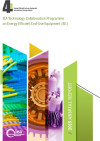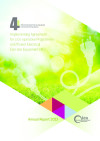Suchergebnisse
IEA-4E Jahresbericht 2015

Herausgeber: IEA - 4E
Englisch, 39 Seiten
Downloads zur Publikation
IEA-4E Jahresbericht 2013

Der Jahresbericht umfasst die wichtigsten Errungenschaften des Jahres 2013, sowie eine Zusammenfassung der Aktivitäten der einzelnen 4E Annexes.
Herausgeber: IEA 4E
Englisch, 46 Seiten
Downloads zur Publikation
The IEA Bioenergy Annual Report 2005

Bioenergy is increasingly utilised to reduce emissions of greenhouse gases (GHG). Various options exist for trading bioenergy and bioenergy services between countries.
Englisch
Eco-Services

Strategies for sustainable development
Forschungsforum
4/1999
Herausgeber: BMVIT
Englisch, 6 Seiten
Downloads zur Publikation
Contracting Platform for SME´s
Evaluation of requirements and framework conditions for the implementation and the operation of a Contracting Platform for SME´s in Austria for the cost efficient identification and realisation of energy efficiency measures.
Conference: Biogas Poland
15. - 16. May 2012
InterContinental Warsaw
Warsaw, PL
Biogas Poland 2012 will explore the opportunities and challenges in the country around the three main types of biogas production.
Green. Building. Solutions.
28. July - 18. August 2013
Vienna, AT
Summer University: First hand ecological knowledge and engineering expertise bundled in a three-week program in the capital of energy efficient building: Vienna. Think sustainable, take care of your future - now.
Excursions "Building of Tomorrow live"
Under the project "Building of tomorrow live" over a year long several excursions to "Building of tomorrow" demonstration projects and other passive houses were organised. Sightseeing opportunities were surveyed, updated several times and published on the web.
Energy Counselling within 60 Minutes
Concept for a high quality, PC supported, 60 minutes energy counselling method, focusing on building refurbishment and new constructions, including a software tested in real counselling situations and a printed documentation.
IEA-SHC Task 66: SOLAR ENERGY BUILDINGS - Integrated solar energy supply concepts for climate-neutral buildings and communities for the "City of the Future”
The energy supply for climate-neutral buildings is based on holistic system concepts that achieve high renewable fractions by intelligently combining technologies, sector coupling, high grid interaction and flexibilization measures. The Solar Energy Buildings Task supports exactly this development. The objective is to identify relevant stakeholders and their needs, to develop a technology portfolio and optimised integrated energy concepts and to give recommendations to policy makers and energy-related companies.
OWA+Quartier - Sustainable refurbishment and energy supply for the historic Otto-Wagner-Areal towards a plus-energy district
Development of thermal and electrical energy supply for the Otto-Wagner-Areal as well as model solutions for construction and building services in order to initiate the redevelopment of the area in the direction of a plus-energy district.
IEA AMT Task 12: Novel 2D materials and laser-based surface processes to increase resource efficiency in mobility applications
Friction and wear cause enormous global costs and CO2 emissions. At the same time, machines should become more and more reliable. Within Task 12, new concepts in material development and surface processes are being examined and advanced in order to reduce friction and wear.
IEA HPT Annex 50: Heat Pumps in Multi-Family Buildings for Space Heating and DHW
The project aims at demonstrating the potentials of heat pump technology for the energy supply of multi-family houses (MFH) and to contribute to the elimination of existing market barriers. Concepts and innovative technology options for heat pumps in MFH will be investigated in detail by means of simulations and experiments. The findings and results will be presented in international expert meetings and disseminated among national heat pump manufacturers, installers and planners.
IEA-GHG Overview 2012

Herausgeber: International Energy Agency - Greenhouse Gas R&D Programme
Englisch, 160 Seiten
Downloads zur Publikation
IEA PVPS Task 1: Strategic PV Analysis & Outreach (Working period until 2022)
This task, which is mandatory for all countries participating in the IEA-PVPS program, has been producing global reports on photovoltaic development since 1993. In addition, content-related priorities are set, or new topics and tasks are developed, which are then sent to the ExCo for decision-making. This gives Task 1 strategic importance for the overall IEA PVPS program.
Testing the sustainable hospital.
Based on a feasibility study an interdisciplinary team of researchers supports hospital practitioners implementing the concept of sustainable development in a pilot hospital. Changes within three key areas should lead to significant improvements.
Design of pumped storage schemes
Development of a new surge tank system for pumped storage schemes (PSS) for the governing of the changing requirements in electricity networks due to integration of renewable, volatile energy sources.
Photovoltaic Roadmap for Austria
Development of a Photovoltaic Roadmap for Austria - a study with the intention to screen the opportunities, economical potential as well as the barriers of the promising technology Photovoltaics as basis for strategic decisions in energy relevant policies.
Gas supply by local mircro grids
Proof of the technical and economic feasibility of the utilization of fermentation gas from agricultural fermentation gas facilities by means of local micro grids.
